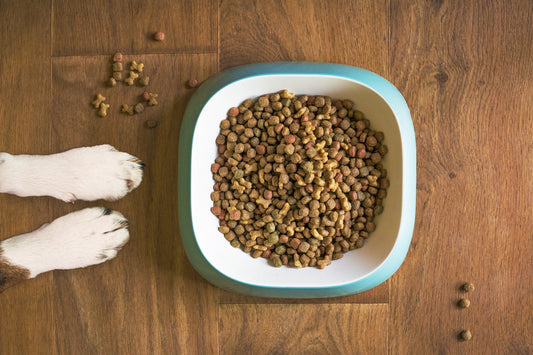Among the essential accessories for your pet are the leash, the bed, the toys... and of course, their bowls! These elements are essential not only for providing them with food and water, but also for ensuring their health. Faced with the wide variety of choices available, how do you choose the best bowl for your dog or cat? It's crucial to carefully consider the bowl's material, its size, and the specific needs of your four-legged friend.
1) The importance of good cleaning
Regardless of the material of your bowl, it's essential to clean it properly, whether it's for food or water. If you've ever run your hand inside the bowl, you may have noticed a slippery film. This phenomenon is caused by a biofilm, a clump of bacterial cells covered in a polymeric substance that adheres to the surface. This biofilm can harbor bacteria such as Listeria, E. coli, or Legionella, promoting their proliferation. These bacteria can also cause urinary tract, bladder, or ear infections in your dog.
It's recommended to wash your dog's food bowl after every meal to avoid contamination. Use warm, soapy water and run it through the dishwasher occasionally, if possible. As for the water bowl, it should be wiped and dried before adding clean water. Many people simply fill it without cleaning it, which makes it easier for biofilm to develop. Wash it thoroughly every few days to ensure good hygiene.
2) The different types of bowls for dogs/cats:
Dog and cat bowls come in a variety of materials, from ceramic to stainless steel to plastic. Each type has its own advantages and disadvantages, which are important to understand in order to make an informed choice.
a) The plastic bowl
Economical and versatile, plastic bowls are available in various sizes, colors, and shapes. Sturdy, they resist drops and are easy to carry when traveling. However, over time, they can become scratched, creating cracks in which bacteria can accumulate, even after cleaning. It will then need to be replaced. Additionally, some dogs can develop a plastic allergy, causing skin reactions. Also, make sure the bowl is free of BPA, a harmful chemical.
b) The stainless steel bowl
Strong and durable, the stainless steel bowl is a wise choice. Virtually indestructible, it cleans easily and is often dishwasher safe. However, it's generally not very aesthetically pleasing, and the available models are often basic. It's also lightweight, which can be a problem if your dog likes to play with his bowl.
c) The ceramic bowl
Ceramic bowls, often BPA-free, are ideal for combining functionality and design. Their heavyweight construction makes them suitable for dogs who tend to move their bowls. They are easy to clean and are generally dishwasher-safe. However, they are fragile and should be inspected regularly for cracks. Once cracked, it's best to replace them, as bacteria can lodge in the cracks.
d) The stoneware bowl
Similar to ceramic, stoneware bowls are heavy but brittle. It's important to ensure the glaze is smooth and waterproof to prevent biofilm buildup. Some models are not dishwasher-safe, so check the instructions carefully.
e) The glass bowl
This type of bowl shares the same advantages and disadvantages as ceramic and stoneware bowls. However, be careful outdoors, as it can concentrate the sun's rays and, in the long run, risk igniting a wooden balcony. Furthermore, glass can heat up quickly.
f) The automatic bowl
Typically made of plastic, automatic bowls allow your dog to have constant access to food or water. However, it's best to use them only for water, as it's important to control the amount of food your dog eats to monitor their weight and health. Additionally, these bowls are more difficult to clean.
g) The silicone transport bowl
Collapsible and lightweight, these silicone bowls are perfect for travel. They're compact and can easily be clipped to a bag or belt. However, they're less durable than traditional bowls and can be easily damaged by a dog's teeth.
h) The interactive or slow-down bowl
If your dog eats too quickly, a slow-feeding bowl is a great solution. Designed to slow down the pace of eating, it helps prevent digestive issues such as bloating or vomiting. This type of bowl is often made of BPA-free plastic and features different structures to help your dog eat more slowly.
3) Choose the right size
In addition to the material, the size of the bowl is an important factor to consider. For different breeds, it's recommended to raise the bowls to aid digestion and prevent gastrointestinal problems. Several models of bowl stands are available on the market, made of wood, plastic, or metal, along with stainless steel, plastic, or ceramic bowls.Opting for a raised stand also helps keep the space clean, as it prevents your dog/cat from moving the bowls.
Conclusion
You now have all the information you need to choose the perfect bowl for your pet, whether for everyday use or travel. Remember that no matter which model you choose, proper maintenance is essential to maintain your pet's health!
So, discover and order our solution now, the anti-splash water bowl, and ensure your dog or cat gets clean, splash-free, and worry-free drinking!
https://ventea.fr/products/bowl-water-anti-splash-dog-cat-1-5-litre





